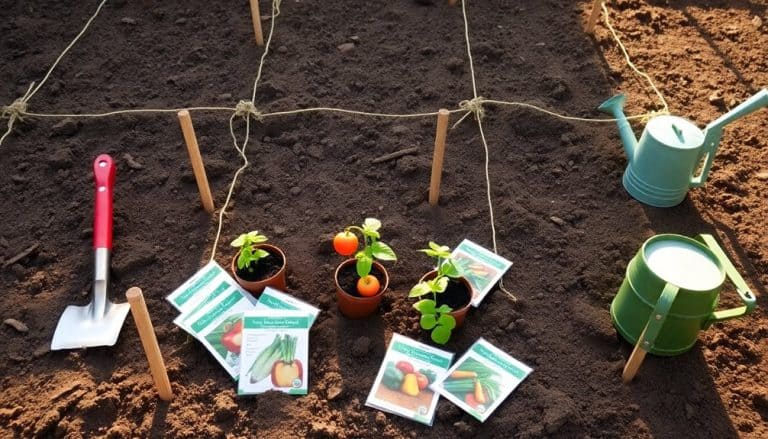This website contains affiliate links. Some products are gifted by the brand to test. As an Amazon Associate, I earn from qualifying purchases. The content on this website was created with the help of AI.
You’ll discover endless ways to transform your garden into a sustainable paradise without breaking the bank in 2024. Start with color-changing solar stake lights under $30, then add charm with repurposed mason jar luminaries and vintage teapot planters. Create vertical interest using rescued pallets for herb gardens and old window frames for succulent displays. Mix in thrifted accessories like weathered watering cans and antique plant stands, grouped artfully for maximum impact. Add solar-powered water features in reclaimed vessels, and define spaces with creative borders made from salvaged materials. Your journey to an eco-chic outdoor sanctuary has just begun.
Key Takeaways
- Transform everyday items like mason jars and tin cans into garden lights using affordable solar LED strands or battery-operated candles.
- Create vertical gardens from recycled pallets and vintage shutters, maximizing space while keeping costs under $50.
- Install color-changing solar stake lights and string lights through garden areas for enchanting nighttime ambiance at budget-friendly prices.
- Repurpose old furniture, kitchenware, and vintage finds into unique planters by adding proper drainage and weather-resistant coatings.
- Design borders using reclaimed materials like brick pavers, glass bottles, or broken concrete pieces arranged in artistic patterns.
Smart Solar Solutions Under

While solar garden decor has traditionally been expensive, today’s market offers stunning yet affordable options that won’t break your budget. You’ll find sleek solar stake lights with color-changing LEDs for under $30, and modern glass orbs that create enchanting light patterns for just $25. These budget-conscious options now feature advanced photovoltaic cells that charge efficiently even in partial shade.
For maximum impact, you’ll want to invest in dual-purpose pieces. Consider solar-powered mason jar lights ($15-20) that serve as both pathway lighting and accent pieces, or hanging solar lanterns ($40-45) that double as daytime sculptures. Today’s affordable options include smart features like auto-dimming and dusk-to-dawn sensors.
To stretch your budget further, look for multi-packs of solar string lights ($35-40) that you can weave through shrubs or drape along fences. Don’t overlook solar-powered ground wash lights ($20-25) that illuminate garden features while remaining nearly invisible during daylight hours. These budget-friendly solutions now incorporate weather-resistant materials and improved battery technology, ensuring they’ll last through multiple seasons despite their affordable price points. Most solar-powered garden lights provide 6-8 hours of illumination after a full day’s charge in direct sunlight.
DIY Pallet Garden Walls

Looking to add vertical interest to your garden without spending a fortune? A DIY pallet garden wall transforms reclaimed wooden pallets into stunning vertical planters that’ll maximize your growing space while creating an eye-catching focal point.
Start by sourcing heat-treated pallets marked with “HT” (avoid chemically-treated ones), and sand down rough edges to prevent splinters. You’ll need to reinforce the structure by adding a backing board and waterproof liner to protect against moisture damage. Create planting pockets by spacing horizontal slats 6-8 inches apart, guaranteeing proper drainage holes at each level.
For mounting, secure your pallet wall to fence posts or a sturdy wall using galvanized brackets and rust-resistant screws. Position it where it’ll receive appropriate sunlight for your chosen plants. You can paint or stain the wood to match your garden’s aesthetic, but remember to use weather-resistant finishes.
Fill the pockets with drought-tolerant succulents, cascading herbs, or seasonal flowers. Install a drip irrigation system with individual emitters for each pocket to guarantee consistent watering. For year-round appeal, incorporate miniature solar lights between the slats or weave fairy lights through the structure. Consider adding a potting bench workspace beneath your pallet wall to create an efficient gardening station for maintaining your vertical garden.
Repurposed Container Gardens
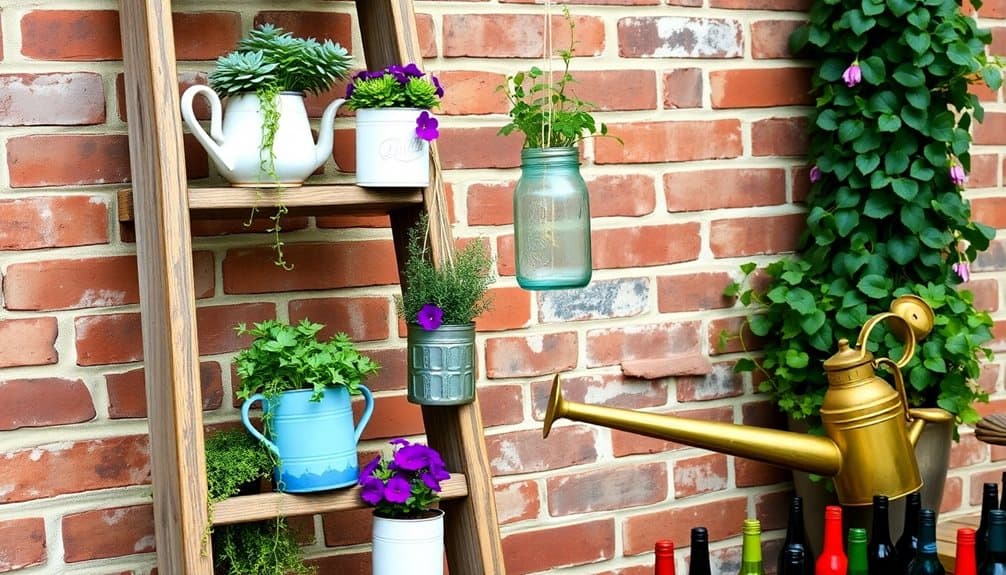
Moving beyond vertical displays, you can transform everyday household items into charming garden containers that showcase your creativity and eco-conscious style. Old dresser drawers, vintage suitcases, and well-worn boots can become unexpected planters that add character to your outdoor space while reducing landfill waste.
When repurposing containers, you’ll need to drill drainage holes and add a layer of gravel before filling with potting soil. Metallic items like wheelbarrows, watering cans, and tool boxes should be lined with coconut coir to prevent rust and extend their lifespan. For wooden containers, apply a non-toxic sealant to protect against moisture damage.
Consider grouping containers of varying heights and materials to create visual interest. You can stack vintage crates for a tiered effect or arrange enamelware containers in a color-coordinated display. Don’t overlook kitchen items – colanders make excellent hanging planters, while chipped teapots serve as whimsical succulent holders. For maximum impact, pair your container choice with complementary plants: trailing vines for elevated pieces, compact herbs for smaller vessels, and drought-resistant specimens for containers with limited soil capacity.
Place humidity trays beneath your container gardens to maintain optimal moisture levels for your plants, especially during dry indoor conditions.
Nature-Inspired Upcycled Art Projects
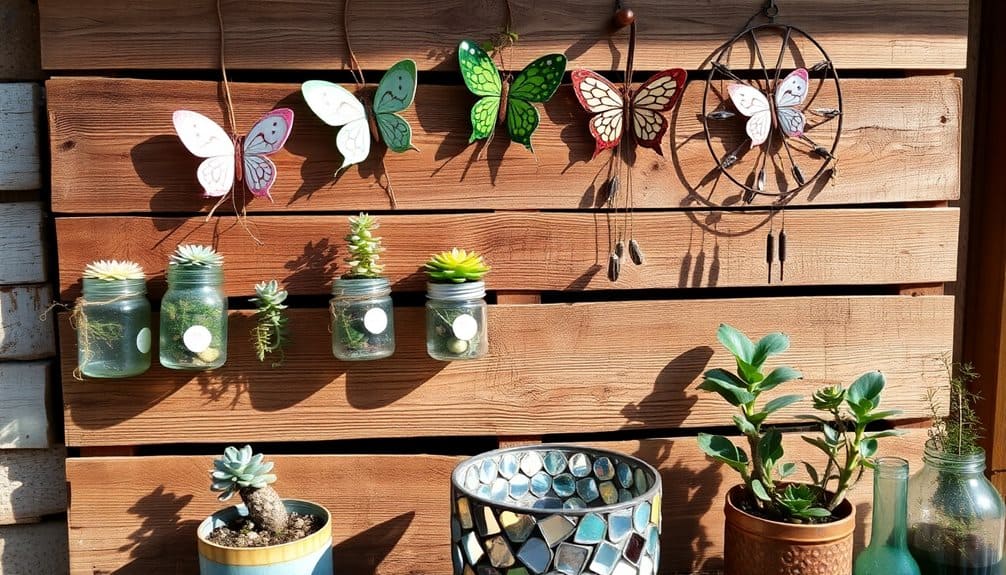
To create enchanting garden art without breaking the bank, you’ll find endless possibilities in discarded materials from your home and neighborhood. Transform old window frames into vertical succulent displays by attaching small terra cotta pots with wire. Convert tarnished silverware into wind chimes or garden markers, bending forks and spoons into whimsical shapes that catch the light.
Turn fallen branches into natural sculptures by wrapping them with copper wire and suspending crystals or colored glass pieces. You’ll breathe new life into broken pottery by creating mosaic stepping stones or wall art using weather-resistant adhesive. Consider fashioning butterfly feeders from vintage teacups and saucers mounted on repurposed copper piping.
Weather-worn wooden pallets can become vertical planters or artistic backdrops when painted with outdoor-safe colors and sealed properly. For dramatic lighting effects, drill patterns into tin cans to create luminaries, or string mason jars with solar-powered LED lights between posts. Don’t overlook the potential of bike wheels, which make excellent trellises when mounted vertically and painted in garden-complementing hues. These upcycled pieces won’t just save money – they’ll add unique character to your outdoor space. Create a cozy corner by installing stuffed animal hammocks between trees to add whimsical charm to children’s garden areas.
Thrifted Vintage Garden Accessories
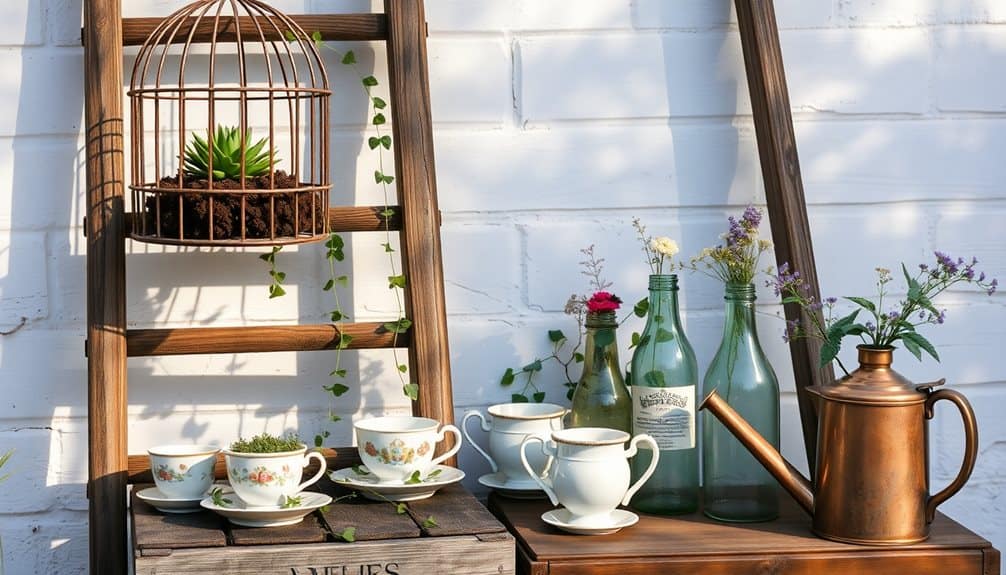
Savvy gardeners know that secondhand stores and estate sales offer treasure troves of vintage accessories that add instant charm to any outdoor space. You’ll find weathered metal watering cans, antique plant stands, and classic terra cotta pots at a fraction of their original prices. Look for brass or copper items that’ll develop a natural patina over time, enhancing your garden’s timeless appeal.
Focus on versatile pieces that serve multiple purposes. Victorian-era wire plant stands can display climbing vines or hold lanterns for evening ambiance. Repurpose vintage ladders as vertical plant displays, or transform old window frames into wall-mounted succulent gardens. Cast iron gates and architectural salvage make striking focal points when used as trellises or wall art.
Don’t overlook smaller accessories like vintage garden tools, which you can group into artistic displays or mount on fence panels. Mid-century planters and concrete birdbaths often surface at estate sales for reasonable prices. When selecting pieces, check for structural integrity and verify metal items aren’t completely rusted through. You’ll want to seal untreated wood items to prevent further weathering and extend their outdoor life. Stylish garden planters can transform any outdoor space into a sophisticated sanctuary while maintaining a budget-friendly approach.
Creative Lighting With Found Objects
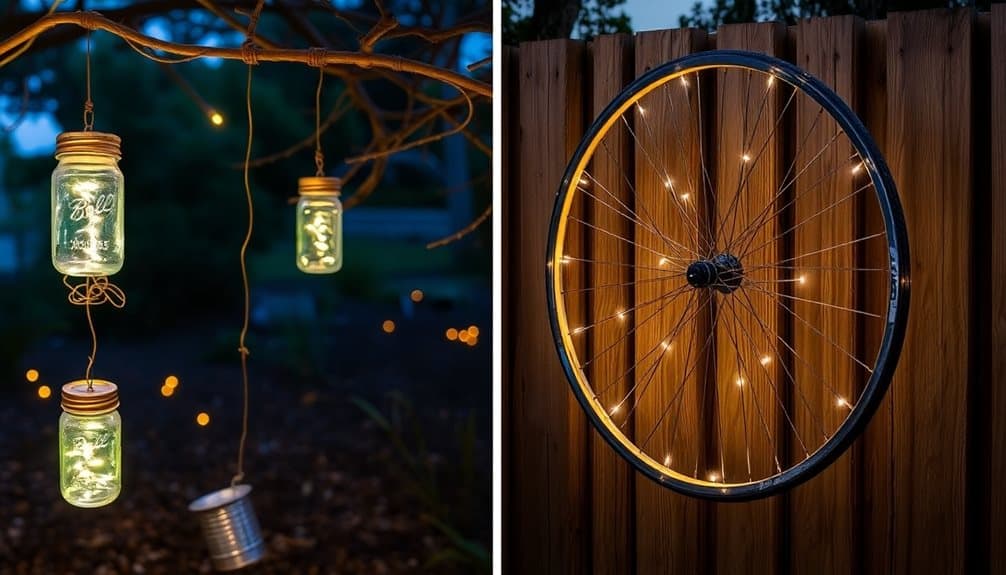
Lighting your garden doesn’t require expensive fixtures when you’re willing to get creative with everyday objects. You’ll find endless possibilities by repurposing glass jars, tin cans, and vintage lanterns into enchanting light sources that add character to your outdoor space.
Transform mason jars into hanging luminaries by wrapping copper wire around the rim and creating a handle. Line pathways with these DIY lights, filling them with battery-operated LED candles or solar-powered fairy lights. For a modern twist, paint tin cans in metallic colors, punch decorative patterns into their sides, and mount them on shepherd’s hooks.
Old colanders and metal buckets become striking overhead lights when you drill holes for light strands to peek through. Position these industrial-style fixtures above dining areas or gathering spaces. Wine bottles can be converted into tiki torches using specialized wicks and fuel, while vintage teapots make unique candleholders when fitted with outdoor-rated flameless candles.
Consider weather-resistant options like coating metal items with clear sealant and using rust-resistant hardware for mounting. Place solar-powered disc lights inside glass containers to eliminate the need for wiring or batteries, ensuring your creative lighting solutions remain practical and maintenance-free.
Sustainable Water Features

Creating a soothing water feature doesn’t have to strain your budget or the environment. By repurposing everyday items and incorporating solar-powered pumps, you’ll achieve tranquil water effects while maintaining eco-consciousness. Transform salvaged containers, ceramic vessels, or vintage watering cans into striking water features that showcase your creative vision.
Consider these sustainable water feature ideas that combine aesthetics with environmental responsibility:
- Install a solar-powered fountain in a reclaimed zinc bucket, creating a self-sustaining focal point that requires zero electricity
- Stack weathered river rocks around a recycled glass vessel to craft a naturalistic waterfall that uses minimal water through recirculation
- Convert an old birdbath into a lily pond with floating solar lights and water-purifying plants
- Design a rain chain water feature using copper pipes or vintage keys, directing rainwater into a collection basin
- Build a bamboo water spout system that channels collected rainwater through hollow stems into a stone basin
Position your water feature where it’ll catch natural light for solar operation and incorporate native aquatic plants to maintain water quality naturally. Use permeable surfaces around the feature to allow excess water to replenish groundwater supplies.
Vertical Herb Garden Designs

For small spaces and tight budgets, vertical herb gardens offer a perfect blend of function and style. You’ll maximize growing space while creating a stunning visual focal point that transforms blank walls into lush, aromatic displays. Using recycled pallets, vintage shutters, or mounted mason jars, you can craft a customized herb garden that costs under $50.
Start by selecting herbs that thrive in vertical configurations – cascading varieties like creeping thyme and trailing rosemary work exceptionally well. Install a moisture-resistant backing board and guarantee proper drainage by drilling small holes in your containers. You’ll need to position your garden where it receives 4-6 hours of sunlight daily, ideally near your kitchen for easy harvesting.
Consider arranging herbs by height and water needs – place drought-tolerant sage and oregano at the top, with moisture-loving basil and parsley below. Add visual interest by incorporating different container sizes and materials, such as terracotta pots, galvanized planters, or repurposed tin cans. Label each herb clearly using painted wooden markers or slate tags, creating both functionality and rustic charm in your vertical display.
Reclaimed Material Garden Borders
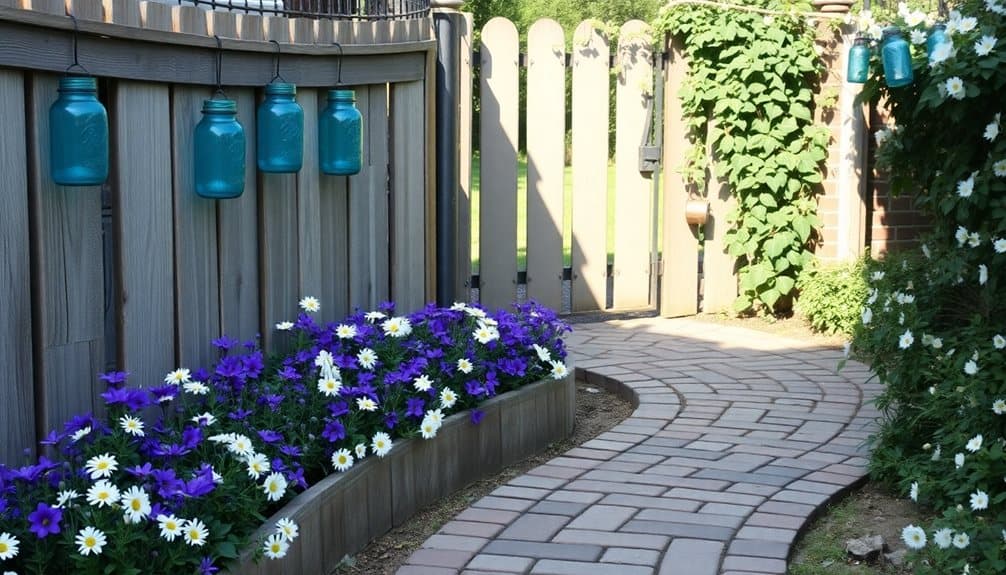
While vertical gardens beautify walls, stylish garden borders define your outdoor spaces with character and charm. You’ll find that reclaimed materials offer an eco-friendly and budget-conscious approach to creating distinctive garden edges that tell a story while serving a practical purpose.
Transform everyday salvaged items into eye-catching borders that’ll make your garden stand out. You can source materials from demolition sites, salvage yards, or even your own home renovation projects. When selecting materials, verify they’re weatherproof and won’t leach harmful substances into your soil.
- Repurposed brick pavers laid in herringbone patterns create classical elegance
- Vintage glass bottles turned upside down form colorful, light-catching boundaries
- Reclaimed timber railway sleepers offer rustic appeal and natural wood tones
- Broken concrete pieces arranged mosaic-style deliver industrial-chic aesthetics
- Salvaged metal panels cut to size provide modern, weathered accents
Position your chosen materials at consistent depths (typically 4-6 inches) to prevent shifting. You’ll want to treat wooden elements with eco-friendly sealants to extend their lifespan, and verify metal pieces are rust-free or intentionally oxidized for effect. Consider mixing materials for added visual interest while maintaining a cohesive design theme.
Frequently Asked Questions
How Long Do Budget Garden Decorations Typically Last in Extreme Weather Conditions?
You’ll find that budget garden decorations typically last 1-3 years in extreme weather, depending on their materials and care. Metal pieces often rust within a year, while untreated wood deteriorates in 6-18 months. Plastic items crack and fade after 1-2 seasons of intense sun or frost. You’ll get the best longevity by storing decorations during harsh weather and applying protective coatings annually.
Can These DIY Garden Projects Affect Home Insurance Coverage?
You’ll want to check your home insurance policy carefully, as DIY garden installations can impact your coverage. Permanent structures like handmade pergolas, water features, or lighting systems might require additional coverage or proper permits. Poorly constructed elements could create liability issues if they cause injury or property damage. It’s best to inform your insurance provider about significant garden projects and verify they’re built to local codes.
What Permits Are Needed for Installing Garden Features in Rental Properties?
You’ll need your landlord’s written permission before installing any garden features in your rental property. For permanent installations like water features, pergolas, or built-in planters, you’ll typically need both the landlord’s approval and local building permits. Check your lease agreement carefully, and contact your local zoning office to verify requirements. Temporary features like container gardens usually don’t require permits but still need landlord consent.
How Do Budget Garden Decorations Impact Property Value During Home Appraisals?
While high-end landscaping can boost property value by 15%, your budget-friendly garden decor won’t greatly impact your home’s appraisal value. You’ll find that well-maintained, low-cost elements like container gardens, painted features, and DIY hardscaping offer aesthetic appeal without measurable financial returns. Focus instead on creating curb appeal that’ll attract potential buyers, even if it doesn’t directly increase your home’s appraised value in dollars.
Are There Neighborhood Regulations That Restrict Certain Types of Garden Decorations?
You’ll find that most neighborhoods have specific regulations governing garden decorations through HOA rules or local ordinances. These typically restrict height, placement, lighting intensity, and reflective materials. You’ll need to check your community’s bylaws for limits on temporary displays, permanent fixtures, water features, and artistic installations. Some areas even regulate color schemes and material types to maintain neighborhood aesthetics.




